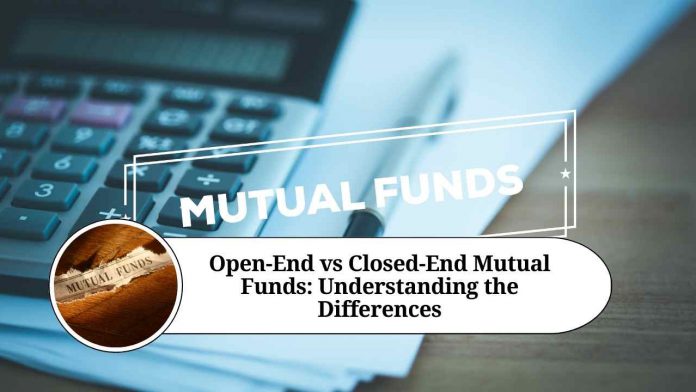When it comes to investing in mutual funds, one of the decisions investors need to make is whether to choose an open-ended or closed-ended fund. Both types of funds offer advantages and disadvantages, and understanding the differences between them can help investors make informed decisions.
Open-Ended Mutual Funds
An open-ended mutual fund is a type of fund that continuously issues new shares and redeems existing shares on demand. This means that investors can buy or sell shares at any time, and the fund’s size can grow or shrink depending on demand.
One of the main advantages of open-ended funds is their liquidity. Because investors can buy and sell shares at any time, they have access to their money when they need it. Additionally, because the fund’s size can change, the fund manager has more flexibility to invest in a wider range of assets and adjust the fund’s holdings based on market conditions.
However, there are also some potential disadvantages to open-ended funds. Because the fund is constantly issuing new shares and redeeming existing shares, there may be more administrative costs associated with managing the fund. Additionally, because the fund is open to new investments at any time, the fund manager may be forced to invest in less attractive assets in order to keep the fund fully invested.
Closed-Ended Mutual Funds
A closed-ended mutual fund, on the other hand, is a type of fund that issues a fixed number of shares through an initial public offering (IPO). After the IPO, the shares trade on an exchange like stocks, and investors can buy and sell shares on the open market.
One of the main advantages of closed-ended funds is that they typically have lower management fees compared to open-ended funds. Additionally, because the fund’s size is fixed, the fund manager has more control over the fund’s investments and can invest in less liquid assets that may not be available to open-ended funds.
However, there are also some potential disadvantages to closed-ended funds. Because the fund’s size is fixed, investors may have difficulty buying or selling shares if there is low demand for the fund. Additionally, because the shares trade on an exchange, the share price may not always reflect the underlying value of the fund’s assets.
Which is Right for You?
Ultimately, the decision of whether to invest in an open-ended or closed-ended fund will depend on your investment goals and risk tolerance. If you need access to your money on a regular basis, an open-ended fund may be the better choice. On the other hand, if you’re looking for exposure to less liquid assets or want to take advantage of potentially lower fees, a closed-ended fund may be more appropriate.
It’s also worth noting that there are hybrid funds that combine elements of both open-ended and closed-ended funds. These funds typically have a fixed number of shares but also offer some degree of liquidity to investors. As always, it’s important to carefully consider your options and consult with a financial advisor before making any investment decisions.
Read more useful content:
- How to invest in mutual funds
- All about mutual funds-types & importance
- The Power of SIP Investment in Mutual Funds
Frequently Ask Question
Q. What is an open-ended mutual fund?
An open-ended mutual fund is a type of fund that continuously issues new shares and redeems existing shares on demand. Investors can buy or sell shares at any time, and the fund’s size can grow or shrink depending on demand.
Q. What is a closed-ended mutual fund?
A closed-ended mutual fund is a type of fund that issues a fixed number of shares through an initial public offering (IPO). After the IPO, the shares trade on an exchange like stocks, and investors can buy and sell shares on the open market.
Q. What are the advantages of open-ended mutual funds?
One of the main advantages of open-ended funds is their liquidity. Investors can buy and sell shares at any time, and the fund’s size can change to reflect market conditions. Additionally, the fund manager has more flexibility to invest in a wider range of assets.
Q. What are the disadvantages of open-ended mutual funds?
Because the fund is constantly issuing new shares and redeeming existing shares, there may be more administrative costs associated with managing the fund. Additionally, the fund manager may be forced to invest in less attractive assets in order to keep the fund fully invested.
Q. What are the advantages of closed-ended mutual funds?
Closed-ended funds typically have lower management fees compared to open-ended funds. Additionally, because the fund’s size is fixed, the fund manager has more control over the fund’s investments and can invest in less liquid assets that may not be available to open-ended funds.
Q. What are the disadvantages of closed-ended mutual funds?
Because the fund’s size is fixed, investors may have difficulty buying or selling shares if there is low demand for the fund. Additionally, because the shares trade on an exchange, the share price may not always reflect the underlying value of the fund’s assets.
Q. Can closed-ended mutual funds be converted to open-ended funds?
In some cases, closed-ended mutual funds may be converted to open-ended funds. This may happen if the fund manager believes that the fund’s assets would be better managed as an open-ended fund.
Q. Which is better, open-ended or closed-ended mutual funds?
There is no definitive answer to this question, as the best choice will depend on your investment goals and risk tolerance. Both types of funds offer advantages and disadvantages, and it’s important to carefully consider your options before making any investment decisions. Consulting with a financial advisor can help you determine which type of fund is right for you.




















